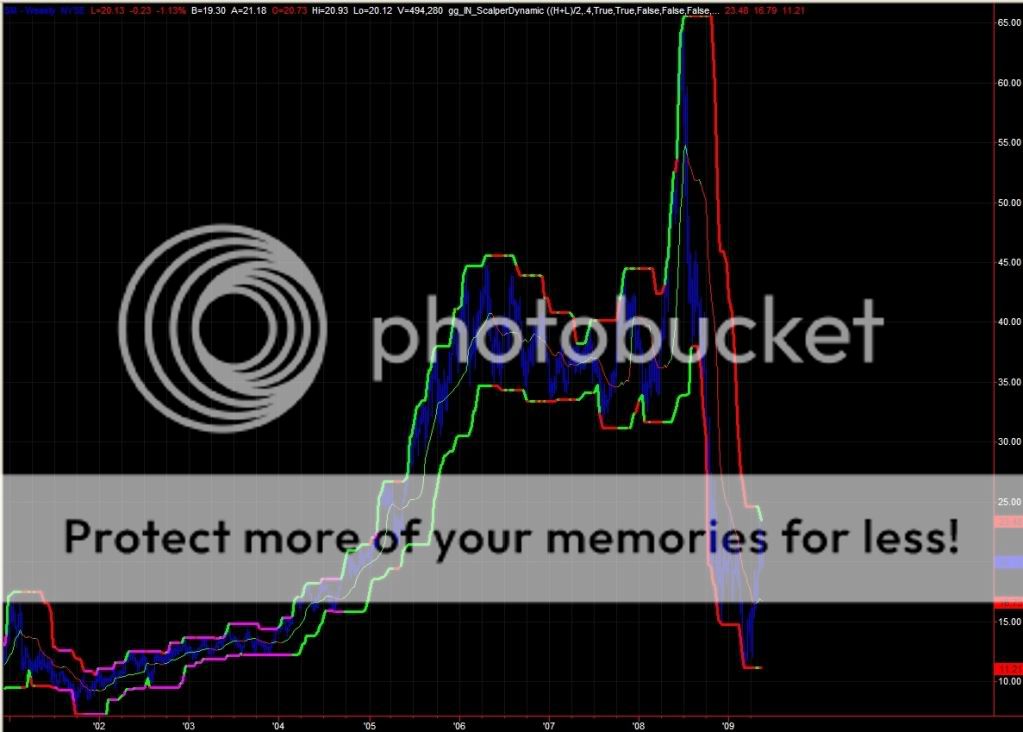


I call it the Scalpers Channel. It's good for the scalper, swing and the position traders. It even works on daily, weekly and monthly charts.
At a glance the Scalpers Channel provides clear, fast and meaningful indication of where the current point of control is of three different cycle lengths of volume or price distribution. In addition it shows previous and current support and resistance. There is a lot going on in this simple looking indicator.
I designed the scalper channel indicator to identify areas of extreme volatility based either on price or volume distribution (relative to the other).
Trading Rules:
The way I use the Scalper Channel is to wait for price to consolidate along one side of the channel, "that's my edge, price consolidation!" 3 bars is enough consolidation. Look at your favorite indicator has it changed direction during the consolidation? If yes take the trade in the direction of your indicator. For example the Volume Control/Bollinger indicator, the MACD Adaptive, Trend Analyzer , etc. My scalper channel is a lot faster or indicates more S/R areas for scalping or taking an ambush trade, than any other channel I have reviewed.
The channel is derived by calculating a statical distribution of price or volume respected to the other; I then I calculate the extrema of this distribution, this is being done with a self adaptive cycle recognition calculation. The channel can be modified with many parameters to accommodate your particular trading style.
Included with the Scalper Channel are Scalper Lines. They indicate an idealized entry point. Typically when you enter a trade at the Scalper line you will take very little heat! They are based on price or volume distribution as mentioned above but with a faster cycle calculation and a smaller distribution profile. This faster calculation and smaller distribution place the Scalper Lines closer to the real time action of the price. It might help you to think of the scalper lines as where is the real time POC (point of control) is located. The closer your entry point is to the scalper channel the less heat you will have to endure. But the reality is more often then not price will be near the mid point of the channel when your indicators fire off. This where the Scalper Value Chart indicator, the Robot Tracker or the Trend Analyzer come in handy. As they will indicate the direction and strength of the next move. Which will give you an edge to take the trade or to let it go.
The Scalpers Channels was also designed to gauge volatility contraction and expansion. I've coded in a volatility alarm which plots a magenta line whenever volatility is less than a user defined value. This is great for finding break out areas. If you are familiar with the TTM Squeeze indicator this and are frustrated with it's entry points then check out my volatility alarm. In addition when your primary oscillator indicator indicates a direction it's a great time to take a scalp and it could be a potential trend move. You can also integrate this alarm into your automated strategy. For example, if you have a break out strategy, setting the volatility alarm to a lower threshold will help you to identify when the market volatility has contracted to a level of where the potential is greatest for larger moves. The converse to this is when the volatility alarm is large and turns off, you have an indication that the market is either trending or range bound.
There is another use for the person who uses semi or fully automated strategies and that is it's ability to caution you of increasing or decreasing volatility. When back testing you can test at what volatility levels your strategy is best suited.
No comments:
Post a Comment
Note: Only a member of this blog may post a comment.